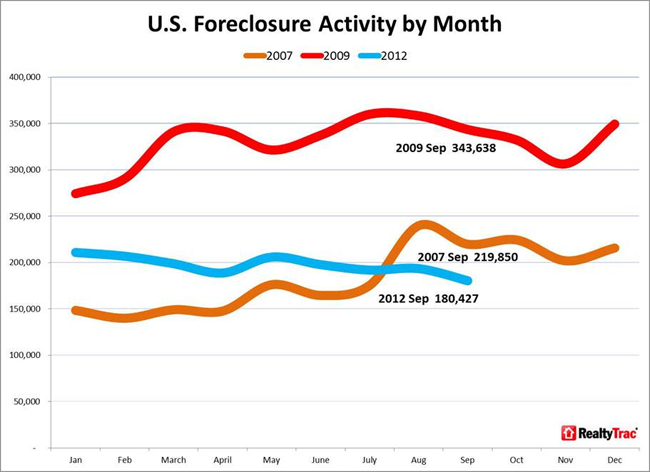Foreclosure activity nationwide fell to the lowest level in September since almost the beginning of the foreclosure crisis according to RealtyTrac's U.S. Foreclosure Market Report released this morning. Foreclosure filings fell 7 percent from the August level to a total of 180,427 or one in every 730 housing units. The total is 16 percent below filings in September 2011 and the lowest since July 2007.
RealtyTrac is an Irvine, California firm that tracks three categories of foreclosure filings gathered from county level sources.
- Notice of Default (NOD) and Lis Pendens (LIS). This is the first legal notification from a lender that the borrower on a mortgage loan has defaulted under the terms of their mortgage and the lender intends to foreclose unless the loan is brought current.
- Auction - Notice of Trustee Sale and Notice of Foreclosure Sale (NTS and NFS): if the borrower does not catch up on their payments the lender will file a notice of sale (the lender intends to sell the property). This notice is published in local paper and contains information pertaining to the date, time and subject property address.
- Real Estate Owned or REO properties : "REO" stands for "real estate owned" and typically refers to the inventory of real estate that banks and mortgage companies have foreclosed on and subsequently purchased through the foreclosure auction if there was no offer higher than the minimum bid.
RealtyTrac's September report includes data on the third quarter and these numbers were the lowest since the fourth quarter of 2007. During the quarter there were filings on 531,576 U.S properties, a decrease of 5 percent from the second quarter and of 13 percent from the third quarter of 2011. This is the ninth consecutive quarter where overall foreclosure activity dropped.

NOD and LIS filings accounted for the decrease in filings as later stage activity actually increased. These two early stage categories totaled 56,148 for the month compared to 99,405 in August. There were 70,710 auctions scheduled for the first time compared to 41,723 the previous month and bank repossessions rose to 53,569 from 52,380.
"We've been waiting for the other foreclosure shoe to drop since late 2010, when questionable foreclosure practices slowed activity to a crawl in many areas, but that other shoe is instead being carefully lowered to the floor and therefore making little noise in the housing market - at least at a national level," said Daren Blomquist, vice president at RealtyTrac. "Make no mistake however; the other shoe is dropping quite loudly in certain states, primarily those where foreclosure activity was held back the most last year.
"Meanwhile, several states where the foreclosure flow was not so dammed up last year could see a roller-coaster pattern in foreclosure activity going forward because of recent legislation or court rulings that substantively change the rules to properly foreclose," Blomquist added. "A backlog of delayed foreclosures will likely build up in those states as lenders adjust to the new rules, with many of those delayed foreclosures eventually hitting down the road."

While numbers at the national level were encouraging severe problems continue in some states and in others they are actually increasing. The national decrease in September and the third quarter were driven mostly by sizable decreases in the non-judicial foreclosure states. Of the 24 non judicial states 20 reported annual decreases in foreclosure activity in the third quarter, some quite substantial. For example, Nevada saw a decrease of 71 percent, Oregon 63 percent, and Utah 60 percent.
Washington State was one of only four non-judicial foreclosure states where foreclosure activity increased in the third quarter, up 70 percent from the previous quarter and up 15 percent from the third quarter of 2011. This was one of the first non-judicial states to enact legislation impacting the foreclosure process following the so-called robo-signing controversy that came to light in October 2010. The state legislature passed a law that took effect in July 2011, requiring lenders to offer mediation to homeowners facing foreclosure.
Meanwhile, third quarter foreclosure activity increased on a year-over-year basis in 14 out of the 26 judicial procedure states. New Jersey, already one of the most active states had a huge 130 percent increase, while New York saw a jump of 53 percent in its already high rate. Indiana, Pennsylvania, Connecticut and Illinois all had increases of 31 to 36 percent
Among the exceptions where judicial states had annual decreases in foreclosure activity in the third quarter included Massachusetts (16 percent decrease) and Wisconsin (12 percent decrease).
Looking only at September figures, Florida foreclosure starts (LIS) in September increased 24 percent on a year-over-year basis, the 11th consecutive month with an annual increase, and the state's foreclosure rate ranked highest nationwide for the first time since April 2005.
On a quarterly basis the states with the highest foreclosure rates were Florida (one in every 117 housing units), Arizona (one in 125 units) and California (also one in 125). Other states ranked high for activity in the third quarter were Illinois, Georgia, Nevada, and Ohio.
Days to foreclose increased to 382 days in the third quarter, up from 378 days in Q2 and 336 days in the third quarter of 2011. Recent legislation and court rulings have extended the foreclosure process in several states in addition to Washington noted above. Consequently time to foreclose increased 62 percent to 193 days in Oregon, 62 percent to 662 days in Hawaii, and 42 percent to 520 days in Nevada.







